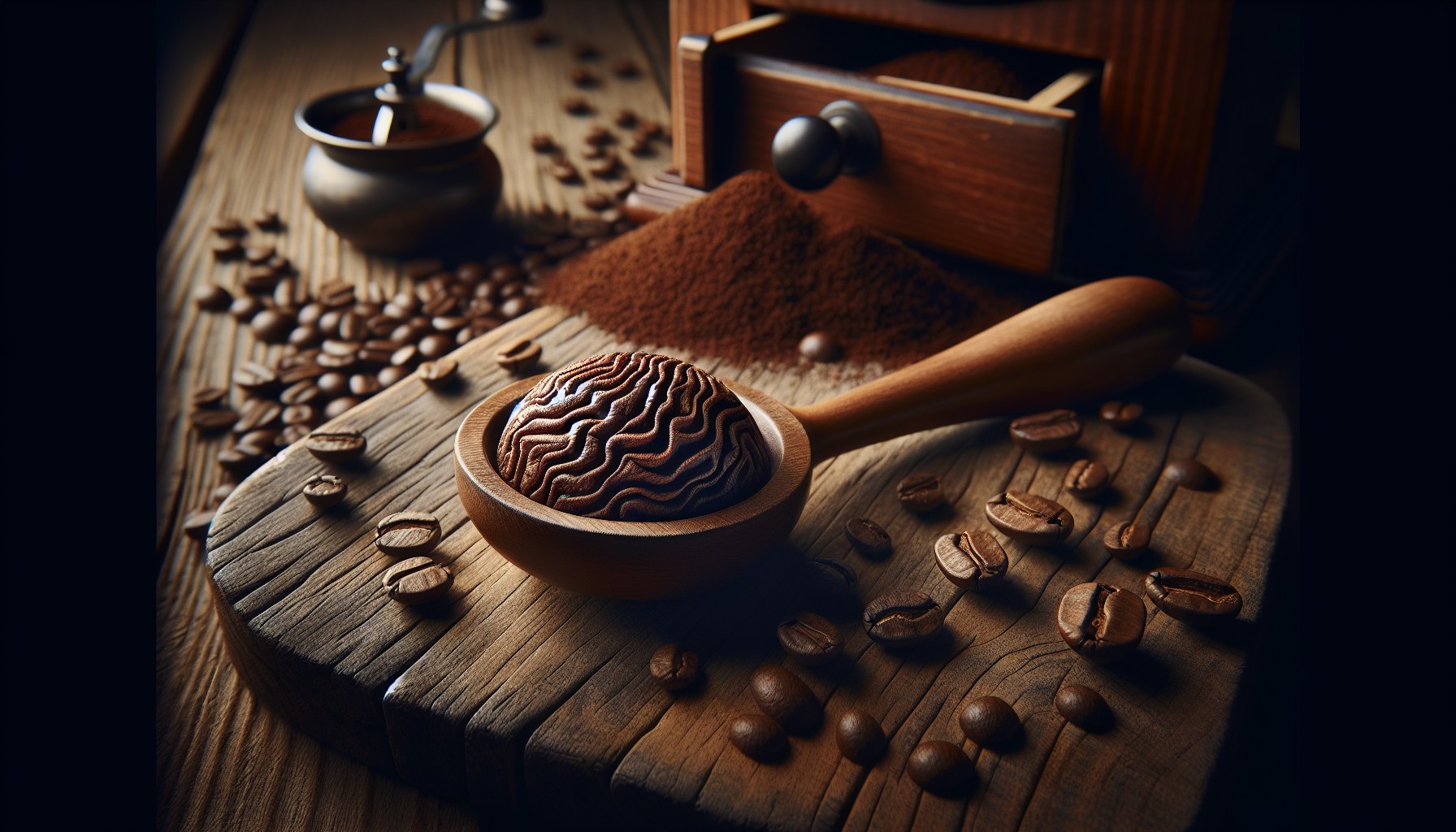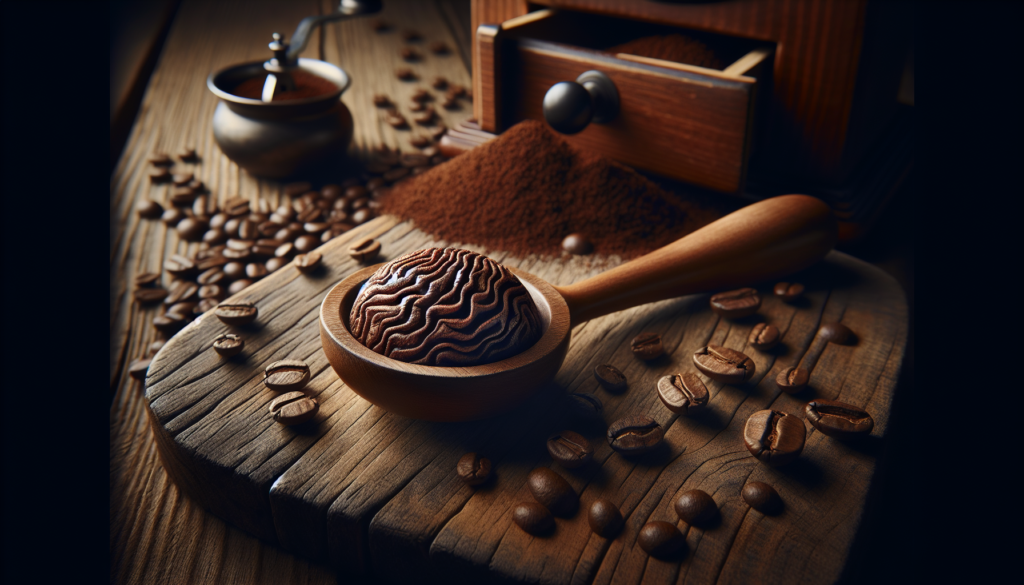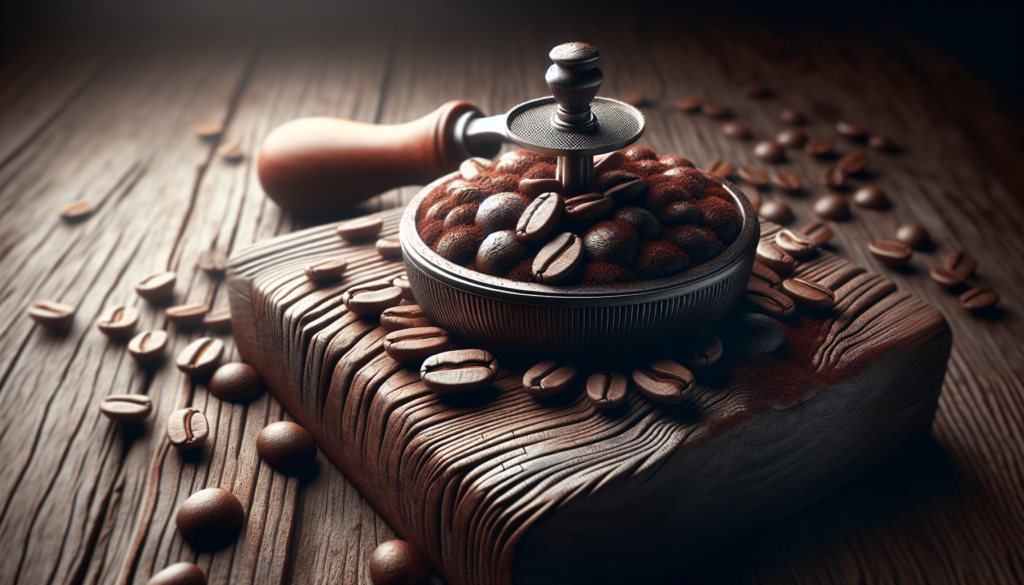
Are you ready to elevate your coffee brewing skills to the next level? In “The Art Of Grinding: Mastering Coffee Textures For Different Brewing Methods,” you will discover the secrets behind achieving the perfect coffee grind for different brewing techniques. Whether you’re a passionate home barista or a coffee shop enthusiast, this article will guide you through the art of grinding, unlocking the key to unlocking the full potential of your favorite beans. From French press to espresso, get ready to embark on a flavorful journey that will leave your taste buds craving more.

Factors Affecting Coffee Texture
Bean Origin
The origin of the coffee beans plays a significant role in determining the texture of the final brew. Different regions and countries produce coffee beans with unique flavor profiles and characteristics. Factors such as soil composition, altitude, climate, and processing methods all contribute to the coffee’s texture. For example, beans from Central America tend to have a smoother texture and brighter acidity, while those from Indonesia often have a heavier body and earthy undertones.
Roast Level
The roast level of coffee beans also affects their texture. Lighter roasts, such as a City or City+ roast, tend to result in a more acidic and delicate texture. On the other hand, darker roasts, like Full City or French roast, bring out a bolder and richer texture with a fuller body. It is important to choose the appropriate roast level based on the desired texture and flavor profile.
Bean Age
The age of the coffee beans can impact the texture of the final brew. Freshly roasted beans generally have a more vibrant and complex texture, as their flavors are at their peak. Over time, the beans lose some of their freshness, resulting in a smoother but potentially less nuanced texture. It is recommended to use beans within a few weeks of their roast date to ensure optimal texture and flavor.
Grinder Type
The type of grinder used to grind the coffee beans is another crucial factor in achieving the desired texture. There are two main types of grinders: burr grinders and blade grinders. Burr grinders offer greater control and consistency in grind size, resulting in a more uniform and even texture. On the other hand, blade grinders tend to produce a less consistent grind, which can lead to uneven extraction and texture variations.
Brewing Methods and Their Ideal Coffee Textures
Espresso
Espresso brewing requires a unique texture that is achieved through specific grinding techniques. The ideal grind size for espresso is fine, resembling powdered sugar. This fine grind allows for optimal extraction in a short amount of time, resulting in a rich and concentrated texture. Additionally, uniformity in grind size is crucial to ensure an even extraction and avoid any over-extraction, which can lead to a bitter taste.
Drip Coffee
Drip coffee brewing typically requires a medium to medium-fine grind size. This grind size allows for a balanced extraction, producing a smooth and well-rounded texture. Consistency in grind size is important to prevent any under-extraction, which can result in a weak and watery texture. With the right grind size and consistency, drip coffee can offer a clean and clear flavor profile.
French Press
French press brewing requires a coarse grind size to achieve the desired texture. The coarser grind allows for the coffee oils and flavors to be extracted over a longer brewing time, resulting in a full-bodied and robust texture. Consistency in grind size is essential to ensure an even extraction and prevent any unpleasant sediment in the final brew. With the right grind and consistency, French press coffee can offer a rich and indulgent texture.
Pour Over
Pour over brewing calls for a medium-fine to fine grind size. This finer grind allows for optimal extraction and a well-balanced texture. Consistency in grind size is crucial to prevent any clogging or uneven extraction during the pour over process. With the right grind and consistency, pour over coffee can showcase delicate flavors and a clean, crisp texture.
Grinding Basics
Burr vs. Blade Grinders
When it comes to choosing a grinder, it is important to understand the differences between burr grinders and blade grinders. Burr grinders feature two serrated plates that crush the coffee beans to a consistent grind size. This consistency ensures an even extraction and a uniform texture. On the other hand, blade grinders use spinning blades to chop the beans, resulting in a less consistent grind and potentially uneven extraction. For those seeking precision and control over their coffee texture, a burr grinder is highly recommended.
Grind Size
Grind size refers to the size of the coffee particles after grinding and is crucial in determining the texture of the final brew. Different brewing methods require specific grind sizes to achieve their desired textures. For example, a fine grind is ideal for espresso, while a coarse grind is suitable for French press brewing. The grind size directly affects the extraction process, and finding the right size for each brewing method is key to producing a flavorful and balanced texture.
Grind Consistency
Consistency in grind size is equally important as the grind size itself. A consistent grind ensures an even extraction, preventing any over-extraction or under-extraction, which can result in off-flavors and an inconsistent texture. Burr grinders are known for their ability to provide a more consistent grind size compared to blade grinders. When using a grinder, it is essential to check the grind consistency regularly to maintain the desired texture in your coffee.
Dos and Don’ts
- Do experiment with different grind sizes and brewing methods to find your preferred texture.
- Do adjust the grind size and consistency based on factors such as bean origin, roast level, and bean age.
- Do clean your grinder regularly to prevent any buildup that can affect grind consistency.
- Don’t grind coffee too fine or too coarse for a specific brewing method, as it can result in an unbalanced texture.
- Don’t overlook the importance of grind consistency in achieving the desired texture and flavor in your coffee.

Achieving the Right Texture for Espresso
Fine Grind Size
For achieving the perfect texture in espresso, a fine grind size is essential. This fine grind allows for a faster and more efficient extraction, resulting in a concentrated and flavorful espresso shot. It is recommended to aim for a grind size that resembles powdered sugar, ensuring optimal extraction without any bitterness.
Uniformity for Even Extraction
In addition to the grind size, uniformity in the grind is crucial for an even extraction and consistent texture. Uneven grind particles can lead to over-extraction in some areas and under-extraction in others, resulting in an imbalanced flavor profile and texture. Using a burr grinder and regularly checking the grind consistency can help achieve the necessary uniformity for a perfect espresso texture.
Avoiding Over-extraction
Over-extraction can lead to a bitter and unpleasant taste in espresso. To avoid over-extraction and achieve the right texture, it is crucial to control the brew time and adjust the grind size accordingly. If the extraction is happening too quickly, resulting in a harsh and bitter taste, a finer grind size can help slow down the process and achieve a smoother texture.
Creating the Perfect Texture for Drip Coffee
Medium to Medium-Fine Grind
Drip coffee brewing requires a medium to medium-fine grind size to achieve the desired texture. This grind size allows for an optimal extraction, resulting in a balanced and flavorful cup of coffee. It is important to find the right grind size that allows water to flow through the coffee bed at a steady pace, neither too fast nor too slow. A medium to medium-fine grind strikes this balance perfectly.
Consistency for Balanced Extraction
Consistency in grind size is crucial to ensure an even extraction and a consistent texture in drip coffee. Uneven particles can lead to inconsistent extraction, resulting in a brew that is either under-extracted or over-extracted. With a consistently ground coffee, the water gravity will work harmoniously to extract the desired flavors and achieve a balanced texture.
Preventing Under-extraction
Under-extraction can result in a weak and watery texture in drip coffee. To prevent this, it is important to adjust the grind size based on the brew time and taste. If the coffee tastes weak and lacks body, it might be under-extracted. In such cases, a slightly finer grind size can help increase the extraction and achieve a fuller texture.
Mastering the French Press Texture
Coarse Grind Size
French press brewing calls for a coarse grind size to achieve the desired texture. The coarse grind allows for a longer brewing time, resulting in a full-bodied and robust coffee. With a larger grind size, the water extracts the flavors and oils from the coffee while maintaining a clean and vibrant texture.
Consistency for Full Bodied Flavor
Consistency in the grind size is vital to ensure a full-bodied flavor in French press coffee. Inconsistent grind particles can lead to uneven extraction, resulting in a brew that is either too weak or too harsh. By using a burr grinder and ensuring uniformity in grind size, you can achieve a rich and indulgent texture in your French press coffee.
Ensuring Proper Extraction
Proper extraction can make the difference between a balanced and flavorful French press coffee and one that falls short of expectations. To achieve the right texture, it is important to find the perfect balance between the coarse grind size and brewing time. If the coffee tastes bitter or astringent, it might be over-extracted. Adjusting the brewing time and using a consistent grind size can help ensure a properly extracted, full-bodied texture.
Crafting the Ideal Texture for Pour Over
Medium-Fine to Fine Grind
Pour over brewing requires a medium-fine to fine grind size to achieve the desired texture. This finer grind allows for a slower extraction, resulting in a delicate and nuanced flavor profile. The water flows through the coffee bed at a controlled pace, allowing for optimal flavor extraction and a clean, crisp texture.
Consistency for Optimal Extraction
Consistency in the grind size is crucial for optimal extraction and a well-rounded texture in pour over coffee. Inconsistent grind particles can result in areas of over-extraction or under-extraction, leading to a brew that lacks balance and complexity. By using a burr grinder and regularly checking the grind consistency, you can achieve a consistently excellent texture in your pour over coffee.
Avoiding Clogging
One common challenge when brewing pour over coffee is clogging. To avoid clogging and achieve the ideal texture, it is important to use the appropriate grind size and ensure consistency. If the coffee drains too slowly or the water flow is impeded, it might be due to a grind that is too fine. Adjusting the grind size slightly coarser can help prevent clogging and achieve a smooth and clean texture.
Choosing the Right Grinder for Your Desired Texture
Burr Grinders
Burr grinders are highly recommended for those seeking precision and control over their coffee texture. These grinders crush the coffee beans between two serrated plates, resulting in a consistent and uniform grind size. The ability to adjust the grind size and achieve a specific texture makes burr grinders a popular choice among coffee enthusiasts. They offer reliability and consistency, ensuring a high-quality brew every time.
Blade Grinders
Blade grinders, while more affordable, are generally not as reliable in achieving a consistent texture. These grinders use spinning blades to chop the coffee beans, resulting in a varied and uneven grind size. Blade grinders can lead to inconsistencies in extraction and texture, as well as potential over- or under-extraction. However, if a burr grinder is not accessible, blade grinders can still be used effectively with proper techniques to achieve a satisfactory texture.
Manual Grinders
Manual grinders offer a more hands-on approach to grinding coffee beans. They require physical effort to grind the beans, but they often provide more control over the grind size and texture. Manual grinders, especially those with burr mechanisms, can produce consistent and high-quality grinds. They are a popular choice for travelers or those looking for a quieter and more portable option without compromising texture and flavor.
Factors to Consider for Consistent Texture
Grinder Adjustments
Regular adjustments to the grinder settings are necessary to achieve consistent texture in coffee brewing. Factors such as bean origin, roast level, and desired brewing method can all influence the optimal grind size. By experimenting and making slight modifications to the grinder settings, you can customize the texture to suit your preferences and ensure a consistently excellent cup of coffee.
Bean-to-Water Ratio
The ratio of coffee beans to water is a crucial factor in achieving a consistent texture. The amount of coffee used affects the strength and extraction of the brew. A higher ratio of coffee to water can result in an intense and bolder texture, while a lower ratio might produce a milder and lighter texture. Finding the right balance based on personal preference and the desired flavor profile is key to consistency in texture.
Water Temperature
Water temperature plays a significant role in extraction and ultimately affects the texture of the coffee. The optimal water temperature for brewing coffee is typically between 195°F and 205°F (90°C to 96°C). Water that is too hot can lead to over-extraction and a bitter texture, while water that is too cold can result in under-extraction and a weak texture. Maintaining a consistent water temperature throughout the brewing process is crucial for achieving a consistent texture.
Brew Time
The brewing time also influences the texture of the coffee. Different brewing methods require specific brew times to achieve the desired texture. Under-extracting the coffee can result in a weak and watery texture, while over-extraction can lead to a bitter and harsh texture. Finding the right balance and adhering to the recommended brew time for each brewing method is essential for consistent and optimal texture.
Common Mistakes to Avoid when Grinding Coffee
Grinding Too Fine
A common mistake when grinding coffee is using a grind size that is too fine for the desired brewing method. Grinding too fine can result in over-extraction and a bitter texture. It is important to understand the ideal grind size for each brewing method and adjust accordingly to achieve the desired texture and flavor profile. Experimenting and finding the right balance can help avoid this common pitfall.
Inconsistent Grind Size
Inconsistency in grind size can have a significant impact on the texture and flavor of the coffee. Uneven particles can lead to variations in extraction, resulting in a brew that lacks balance and uniformity. Regularly checking the grind consistency and using a burr grinder can help achieve a more even grind, leading to a consistent and delightful texture in your coffee.
Using Dull Grinder Burrs
Over time, grinder burrs can become dull, affecting the quality and consistency of the grind. Dull burrs can lead to an inconsistent grind size, resulting in variable extraction and texture. It is important to maintain and replace grinder burrs regularly to ensure optimal performance and a consistent texture in your coffee.
Improper Storage of Beans
Improperly storing coffee beans can compromise their freshness and texture. Exposure to air, moisture, heat, and light can lead to flavor deterioration and a less vibrant texture. It is recommended to store coffee beans in an airtight container in a cool, dark place to maintain their freshness and the desired texture. Avoid storing coffee beans in the refrigerator or freezer, as the frequent temperature changes can affect the texture and flavor of the beans.
In conclusion, achieving the perfect coffee texture requires consideration of various factors, including bean origin, roast level, bean age, and grinder type. Different brewing methods also call for specific textures, with espresso requiring a fine grind, drip coffee requiring a medium to medium-fine grind, French press requiring a coarse grind, and pour over requiring a medium-fine to fine grind. Consistency in grind size and proper extraction are key to achieving the desired texture and flavor in each brewing method. Choosing the right grinder and avoiding common mistakes such as grinding too fine or inconsistently can greatly enhance the overall coffee experience. With an understanding of these factors and techniques, you can master the art of grinding and unlock a world of delightful coffee textures.